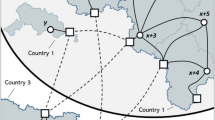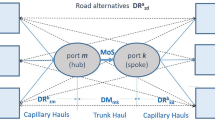Abstract
The objective of this study is to develop a generic model for evaluating the potential demand for short sea shipping (SSS) in a given route. This model can be used in feasibility studies for novel SSS services, when shipping companies evaluate the potential demand for the service, considering the amount of cargo carried between regions and the potential for modal shift from road to sea. A model of costs and transit time across the entire supply chain is developed for unimodal and intermodal transport solutions based on cargo ro-ro ships. The model includes decision-making criteria on the preferable transport solution. The model is applied to the route between Leixões and Lisbon, for which the overall demand for cargo transport is obtained from statistical data relating to exports and imports split by NUTS 2 regions. The model produces the amounts of cargo that could potentially be carried annually through each transport solution, for different freight rates and ship speeds, and allowing the identification of NUTS 2 regions for which the SSS solution is competitive. A sensitivity analysis is carried out to assess the effects of changes in several model parameters on results.















Similar content being viewed by others
Notes
NUTS 2 means Nomenclature of Units for Territorial Statistics and is a geocode standard for referencing the subdivisions of countries for statistical purposes in the European Union. The number 2 indicates an intermediate level of subdivision.
References
Aperte, X.G. and Baird, A.J. (2013) Motorways of the sea policy in Europe. Maritime Policy & Management 40(1): 10–26.
Atlantic Corridor. (2014) Rail Freight Corridor N 4 – Corridor Information Document, http://www.atlantic-corridor.eu/, accessed March 2015.
Baindur, D. and Viegas, J. (2011) Challenges to implementing motorways of the sea concept – Lessons from the past. Maritime Policy & Management 38(7): 673–690.
Bína, L., Bínová, H., Březina, E., Kumpošt, P. and Padělek, T. (2014) Comparative model of unit costs of road and rail freight transport for selected European countries. European Journal of Business and Social Sciences 3(4): 127–136.
Becker, J.F.F., Burgess, A. and Henstra, D.A. (2004) No need for speed in short sea shipping. Maritime Economics and Logistics 6(3): 236–251.
CLdN. (2015) Roro services. http://www.cldn.com/roro_cldn_roro.html, accessed May 2015.
Delhaye, E., Breemersch, T., Vanherle, K., Kehoe, J., Liddane, M. and Riordan, K. (2010) Compass – The Competitiveness of European Short-Sea Freight Shipping Compared with Road and Rail Transport. Final Report, Transport and Mobility Leuven & Nautical Enterprise, Leuven, Belgium.
EU. (1992) The future development of common transport policy. COM (92) 494 final Brussels, Belgium: Commission of the European Communities.
EU. (1995) The development of short sea shipping: Prospects and Challenges. COM (95) 317 final Brussels, Belgium: Commission of the European Communities.
EU. (1999) The development of short sea shipping in Europe: A dynamic alternative in a sustainable transport chain. COM (99) 317 Brussels, Belgium: European Commission.
EUROSTAT. (2015) Gross domestic product (GDP) at current market prices by NUTS 2 regions. http://www.ec.europa.eu/eurostat/statistics-explained/index.php/GDP_at_regional_level, accessed March 2015.
Feo, M., Espino, R. and García, L. (2011) A stated preference analysis of Spanish freight forwarders modal choice on the south-West Europe Motorway of the sea. Transport Policy 18(1): 60–67.
FerryFreight. (2015) AFerryFreight – Freight ferry booking service. http://www.aferryfreight.co.uk, accessed May 2015.
Hossain, K.S. (2009) Cost model for pre – and post-haulage road freight transport to and from the intermodal terminal. MSc thesis, KTH, Stockholm, Sweden.
Instituto Nacional de Estatísticas. (2013) Transport Statistics (in Portuguese). Lisbon, Portugal: Instituto Nacional de Estatísticas.
Janic, M (2007) Modelling the full costs of an intermodal and road freight transport network. Transportation Research Part D 12(1): 33–44.
Korzhenevych, A. et al (2014) Update of the handbook on external costs of transport, Report MOVE/D3/2011/571, DG-MOVE, Brussels, Belgium.
Maibach, M. et al (eds.) (2008) Handbook on Estimation of External Cost in the Transport Sector. Internalisation Measures and Policies for All external Cost of Transport (IMPACT), Version 1.1. Delft, The Netherlands: European Commission DG TREN.
Malfaz, X.A. (2007) Optimization of freight transportation through short sea shipping (in Spanish). PhD Thesis, Department of Transport Engineering, Polytechnic University of Cataluña, Barcelona.
Martínez-López, A., Kronbak, J. and Jiang, L. (2013) Cost and time models for road haulage and intermodal transport using Short sea shipping in the north sea region. Proceedings of IAME 2013 Conference, 3–5 July, Marseille, France.
Martínez-López, A., Sobrino, P.C. and Santos, L.C. (2015) Definition of optimal fleets for sea motorways: The case of France and Spain on the Atlantic coast. International Journal of Shipping and Transport Logistics 7(1): 89–113.
Martínez-López, A., Sobrino, P.C., Santos, L.C. and Torres, B.P. (2012) The optimization of a fleet for the sea motorway: Vigo-St. Nazaire. Proceedings of Short Sea Shipping 2012, 2–3 April, Lisbon, Portugal.
Medda, F. and Trujillo, L. (2010) Short-sea shipping: An analysis of its determinants. Maritime Policy & Management 37(3): 285–303.
Morales-Fusco, P., Sauri, S. and Lago, A. (2012) Potential freight distribution improvements using motorways of the sea. Journal of Transport Geography 24(September): 1–11.
Ng, A.K.Y. (2009) Competitiveness of short sea shipping and the role of port: The case of North Europe. Maritime Policy & Management 36(4): 337–352.
Paixão Casaca, A.C. and Marlow, P.B. (2009) Logistics strategies for short sea shipping operating as part of multimodal transport chains. Maritime Policy & Management 36(1): 1–19.
Prado, R.R., Pereira, D.C., Vilas, D.R., Monteil, N.R. and Valle, A.G. (2014) A parameterized model of multimodal freight transportation for maritime services optimization. International Journal of Simulation and Process Modelling 9(1/2): 33–45.
Psaraftis, H.N. and Kontovas, C.A. (2010) Balancing the economic and environmental performance of maritime transportation. Transportation Research Part D 15(8): 458–462.
Ricci, A. (2003) Pricing of intermodal transport. Lessons learned from RECORDIT. European Journal of Transport and Infrastructure Research 3(4): 351–370.
Sambracos, E. and Maniati, M. (2012) Competitiveness between short sea shipping and road freight transport in mainland port connections; The case of two Greek ports. Maritime Policy and Management 39(3): 321–337.
Santos, T.A. and Guedes Soares, C. (2008) Analysis of trends in cargo handling in portuguese ports. (in Portuguese). In: C. Guedes Soares and C. Costa Monteiro (eds.) O Sector Marítimo Português. Lisboa, Portugal: Edições Salamandra, Lda.
Sauri, S. (2006) Cost structure in a short sea shipping line. Journal of Maritime Research III(2): 53–66.
Soares, J. (2003) Short Sea Shipping, a possible solution? Or just a dream? (in Portuguese) Agência Portuguesa de Promoção do TMCD, Lisboa, Portugal.
Styhre, L. (2009) Strategies for capacity utilisation in short sea shipping. Maritime Economics & Logistics 11(4): 418–437.
Suardiaz. (2015) Suardiaz Atlântica, http://www.suardiaz.com, accessed May.
Suárez-Alemán, A., Trujillo, L. and Cullinane, K.P.B. (2014) Time at ports in short sea shipping: When timing is crucial. Maritime Economics & Logistics 16(4): 399–417.
Tzannatos, E., Papadimitriou, S. and Katsouli, A. (2014) The cost of modal shift: A short sea shipping service compared to its road alternative in Greece. European Transport\Transporti Europei 1(56): 1–20.
Acknowledgements
This work was carried out under the Strategic Research Plan of the Centre for Marine Technology and Ocean Engineering, which is financed by the Portuguese Foundation for Science and Technology (Fundação para a Ciência e Tecnologia-FCT). The authors would also like to thank the two anonymous referees of this article for their useful comments.
Author information
Authors and Affiliations
Corresponding author
Rights and permissions
About this article
Cite this article
Santos, T., Soares, C. Modeling transportation demand in short sea shipping. Marit Econ Logist 19, 695–722 (2017). https://doi.org/10.1057/mel.2016.9
Published:
Issue Date:
DOI: https://doi.org/10.1057/mel.2016.9




